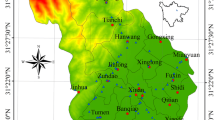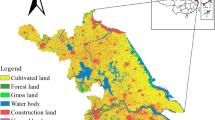Abstract
Given the complexity of land use activities, land ecological suitability analysis can reflect the advantages of regional natural resources and the potential of socioeconomic development. Thus, it could provide scientific evidence for environmentally land use planning in agricultural oasis cities. This research analyzes the principal conflicts and restrictive conditions of regional land use in the main agricultural oasis of the middle reaches of the Heihe River, and identified two kinds of antagonistic forces, i.e., agricultural oasis expansion and ecological conservation land expansion. Then, the minimum accumulative resistance theory and ecology assessment method are introduced to construct a comprehensive land use security model that meets ecological suitability. Furthermore, the strategic patches and radiation corridors for agricultural oasis expansion in the region are recognized through the model calculation. The main conclusions of the model are as follows. First, land use in the region can be clearly divided into four categories: key protected zone, buffer protected zone, moderate developed zone and optimized developed zone. Second, agricultural oasis expansion shows significant strategic patches and radiation corridors information. The strategic point locations are characterized by high-quality soil, rich water resources and outstanding location advantages; while the radiation corridors of each county indicates the direction for ecological suitability, which is significantly affected by the spatial distribution of traffic arteries and ecologically sensitive areas. Third, rural residents can be divided into five categories by the unit of town. Only after effectively identifying the potential and limiting factors of each type could the objective of sustainable management in the arid oasis be achieved.







Similar content being viewed by others
References
Bonham-Carter GF (1994) Geographic information systems for geoseientists: modeling with GIS. Pergamon Press, New York
Campbell JC, Radke J, Gless JT, Wirtshafter RM (1992) An application of linear programming and geographic information systems: cropland allocation in Antigua. Environ Plan 24:535–549. doi:10.1068/a240535
Cao Z, Wang X, Li W, Ye Z, Guo B (2012) Suitable scale for oasis in lower reaches of Tarim River. Arid Land Geogr 35:806–814
Chang X, Han Y, Sun X, Zhang N (2012) Landscape change during oasis expansion process in arid zone. J Desert Res 32:857–862
Chen H, Yao Z, Su F (2005) Eco-environmental reconstruction and its relation with urbanization in west of China. J Desert Res 25:357–363
Chinese Academy of Sciences (2007) Vegetation atlas of China (1:1000 000). Science Press, Beijing
Du Q, Xu X, Liu W (2004) Ecological security assessment for the oases in the middle and lower Heihe River. Acta Ecol Sin 24:1917–1923
Eastman JR, Kyem PA, Toledano J, Jin W (1993) GIS and decision making. UNITAR, Geneva
Fan J (2007) The scientific foundation of major function oriented zoning in China. Acta Geogr Sin 62:339–350
Fischer G, Nachtergaele F, Prieler S, van Velthuizen HT, Verelst L, Wiberg D (2008) Global agro-ecological zones assessment for agriculture (GAEZ 2008). FAO, Rome
Forman RT, Godron M (1986) Landscape ecology. Wiley, New York
Fortin MJ, Agrawal AA (2005) Landscape ecology comes of age. Ecology 86:1965–1966. doi:10.1890/05-0003
Heihe Data Management Center (2011) Reservoirs map of the Heihe river basin. Cold and Arid Regions Environmental and Engineering Research Institute, Chinese Academy of Sciences, Gansu
Janssen R, Rietveld P (1990) Multicriteria analysis and geographical information systems: an application to agricultural land use in the Netherlands. In: Scholten HJ, Stillwell JCH (eds) Geographical information systems for urban and regional planning. Kluwer Academic Publishers, Dordrecht, pp 326–339
Jiao L, Liu Y (2007) Model of land suitability evaluation based on computational intelligence. Geo Spat Inf Sci 10:151–156. doi:10.1007/s11806-007-0053-9
Knaapen JP, Scheffer M, Harms B (1992) Estimating habitat isolation in landscape. Landsc Urban Plan 23:1–16. doi:10.1016/0169-2046(92)90060-D
Li J, Liu X (2006) Research of the nature reserve zonation based on the least-cost distance model. J Nat Resour 21:217–224
Li X, Liu X, Peng X (2007) Niche-based cellular automata for sustainable land use planning. Acta Ecol Sin 27:2391–2402
Liu X, Ma M (2011) Irrigation ditch map in Zhangye city. Cold and Arid Regions Environmental and Engineering Research Institute, Chinese Academy of Sciences, Gansu
Liu X, Shu J, Zhang L (2010) Research on applying minimal cumulative resistance model in urban land ecological suitability assessment: as an example of Xiamen City. Acta Ecol Sin 30:421–428
Marull J, Pino J, Mallarach JM, Cordobilla MJ (2001) A land suitability index for strategic environmental assessment in metropolitan areas. Landsc Urban Plan 81:200–212. doi:10.1016/j.landurbplan.2006.11.005
McHarg I (1969) Design with nature. Natural History Press, New York
Meng J (2011) Land evaluation and management. Science Press, Beijing
Meng L, Zheng X, Zhao L, Deng J (2011) Land-use functional regionalization based on niche-fitness model. Trans Chin Soc Agric Eng 27:282–287
Miller W, Collins WMG, Steiner FR, Cook E (1998) An approach for greenway suitability analysis. Landsc Urban Plan 42:91–105. doi:10.1016/S0169-2046(98)00080-2
Moreno D, Seigel M (1988) A GIS approach for corridor sitting and environment impact analysis. In: Proceedings from the third annual international conference, San Antonio, TX, pp 507–514
Odum EP (1971) Fundamentals of ecology. W. B. Saunders, Philadelphia
Ouyang Z, Wang R, Fu G (1996) Ecological niche suitability model and its application in land suitability assessment. Acta Ecol Sin 16:113–120
Pereira JMC, Duckstein L (1993) A multiple criteria decision-making approach to GIS-based land suitability evaluation. Int J Geogr Inf Syst 7:407–424. doi:10.1080/02693799308901971
Qu Y, Zhang F, Jiang G (2010) Suitability evaluation and subarea control and regulation of rural residential land based on niche. Trans Chin Soc Agric Eng 26:290–296
Stoms DM, McDonald JM, Davis FW (2002) Fuzzy assessment of land suitability for science research reserves. Environ Manage 29:545–558
Tang H, Debavye J, Ruan D (1991) Land suitability classification based on fuzzy set theory. Pedologie 41:194–201
Wu C, Hu Y, Huang P, Liu M, Ren D (2013) Suitability evaluation of cities and rural settlements in Fuxin based on the model of least resistance. Resour Sci 35:2405–2411
Yu K (1999) Landscape ecological security patterns in biological conservation. Acta Ecol Sin 19:8–15
Yu J, Nie Y, Zhou Y, He Y (2006) Niche-fitness theory and its application to GIS-based multi-suitability evaluation of cultivated land. Acta Pedol Sin 43:190–196
Zong Y, Wang R, Wang C, Wang H, Zhang L (2007) Ecological suitability assessment on land use based on potential-constrain approach: the case of urbanized areas in Dalian city, China. Geogr Res 26:1117–1126
Acknowledgments
This research was funded by the National Natural Science Foundation of China (Grant Numbers 40871048, 41506140).
Authors’ contribution
XYY originally formulated the idea and designed the model. MJJ performed statistical analyses, and XYY wrote the manuscript. All the authors conceived the study.
Author information
Authors and Affiliations
Corresponding author
Ethics declarations
Conflict of interest
The authors declare that they have no conflict of interest.
Ethical approval
This article does not contain any studies with human participants or animals performed by any of the authors.
Rights and permissions
About this article
Cite this article
Xiang, Y., Meng, J. Research into ecological suitability zoning and expansion patterns in agricultural oases based on the landscape process: a case study in the middle reaches of the Heihe River. Environ Earth Sci 75, 1355 (2016). https://doi.org/10.1007/s12665-016-6165-5
Received:
Accepted:
Published:
DOI: https://doi.org/10.1007/s12665-016-6165-5




